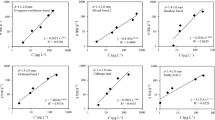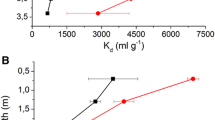Abstract
The fixation capability of cesium on five recycling materials was compared through two sets of sorption experiments using the materials mixed with and without soil. The estimated Freundlich constant K and the distribution of sorbed cesium on the materials revealed a general order of the fixation capability as carbonized sludge > coconut shell biochar > incinerated sewage sludge ash > rice husk biochar > slag. Parametric strong positive correlations were found existent between the fixation capability of cesium and the property-related indexes of the materials such as cation exchange capacity, organic matter content and the potassium concentration.







Similar content being viewed by others
References
Ashraf M, Akib S, Maah M, Yusoff I, Balkhair K (2014) Cesium-137: radio-chemistry, fate, and transport, remediation, and future concerns. Environ Sci Technol 44:1740–1793
Forest Agency (2014) Forest products and radioactive materials-toward the revival of forest and forestry of Fukushima [published in Japanese], Forestry and Forest Products Research Institute
Juget F, Nedjadi Y, Buchillier T, Bochud F, Bailat C (2016) Determination of 137Cs half-life with an ionization chamber. Appl Radiat Isot 118:215–220
Vanderheyden SRH, Van Ammel R, Sobiech-Matura K, Vanreppelen K, Schreurs S, Schroeyers W, Yperman J, Carleer R (2016) Adsorption of cesium on different types of activated carbon. J Radioanal Nucl Chem 310(1):301–310
Kinoshita N, Sueki K, Sasa K, Kitigawa J-i, Ikarashi S, Nishimura T, Wong Y-S, Satou Y, Handa K, Takahashi T, Sato M, Yamagata T (2011) Assessment of individual radionuclide distributions from the Fukushima nuclear accident covering central east Japan. Proc Natl Acad Sci 108:19526–21952
Fukushima Revitalization Station, Fukushima Prefecture homepage. http://www.pref.fukushima.lg.jp/site/portal/list272-1246.html. Accessed 11 Sep 2018
Sugiura Y, Ozawa H, Umemura M, Takenaka C (2016) Soil amendments effects on radiocesium translocation in forest soils. J Environ Radioact 165:286–295
Yao Z, Li J, Xie H, Yu C (2012) Review on remediation technologies of soil contaminated by heavy metals. Procedia Environ Sci 16:722–729
Gadepalle VP, Ouki SK, Herwijnen RV, Hutchings T (2007) Immobilization of heavy metals in soil using natural and waste materials for vegetation establishment on contaminated sites. Soil Sediment Contam 16(2):233–251
Guo G, Zhou Q, Ma LQ (2005) Availability and assessment of fixing additives for the in situ remediation of heavy metal contaminated soils: a review. Environ Monit Assess 116:513–528
Lee SH, Lee JS, Choi YJ, Kim JG (2009) In situ stabilization of cadmium-, lead-, and zinc-contaminated soil using various amendments. Chemosphere 77(8):1069–1075
Namgay T, Singh B, Singh BP (2010) Influence of biochar application to soil on the availability of As, Cd, Cu, Pb, and Zn to maize (Zea mays L.). Aust J Soil Res 48:638–647
Li J, Poon CS (2017) Innovative solidification/stabilization of lead contaminated soil using incineration sewage sludge ash. Chemosphere 173:143–152
Li F, Bade R, Oh S, Shin WS (2012) Immobilization of heavy metals in a contaminated soil using organic sludge char and other binders. Korean J Chem Eng 29(10):1362–1372
Houben D, Evrard L, Sonnet P (2013) Mobility, bioavailability and pH-dependent leaching of cadmium, zinc and lead in a contaminated soil amended with biochar. Chemosphere 92:1450–1457
Hamilton TF, Martinelli RE, Kehl SR, Hayes MH, Smith IJ, Peters SK, Tamblin MW, Schmitt CL, Hawk D (2016) A preliminary assessment on the use of biochar as a soil additive for reducing soil-to-plant uptake of cesium isotopes in radioactively contaminated environments. J Radioanal Nucl Chem 307(3):2015–2020
Tang J, Zhu W, Kookana R, Katayama A (2013) Characteristics of biochar and its application in remediation of contaminated soil. J Biosci Bioeng 116(6):653–659
Duan JM, Su B (2014) Removal characteristics of Cd (II) from acidic aqueous solution by modified steel-making slag. Chem Eng J 246:160–167
Bierman PM, Rosen CJ (1994) Sewage sludge incinerator ash effects on soil chemical properties and growth of lettuce and corn. Commun Soil Sci Plant Anal 25(13–14):2409–2437
Pan SC, Lin CC, Tseng DH (2003) Reusing sewage sludge ash as adsorbent for copper removal from wastewater. Resour Conserv Recycl 39(1):79–90
Kumpiene J, Lagekvist A, Maurice C (2008) Stabilization of As, Cr, Cu, Pb and Zn in soil using amendments. Waste Manag 28:215–225
Sun YB, Sun GH, Xu YM, Wang L, Lin DS, Liang XF, Shi X (2012) In situ stabilization remediation of cadmium contaminated soils of wastewater irrigation region using sepiolite. J Environ Sci 24(10):1799–1805
Bostick BC, Vairavamurthy MA, Karthikeyan KG, Chorover J (2002) Cesium adsorption on clay minerals: an EXAFS spectroscopic investigation. Environ Sci Technol 36(12):2670–2676
Bouzidi A, Souahi F, Hanini S (2010) Sorption behavior of cesium on Ain Oussera soil under different physicochemical conditions. J Hazard Mater 184(1–3):640–646
Giannakopoulou F, Haidouti C, Chronopoulou A, Gasparatos D (2007) Sorption behavior of cesium on various soils under different pH levels. J Hazard Mater 149(3):553–556
Vinichuk M, Rosén K, Johanson KJ, Dahlberg A (2011) Correlations between potassium, rubidium and cesium (133Cs and 137Cs) in sporocarps of Suillus variegatus in a Swedish boreal forest. J Environ Radioact 102(4):386–392
Koarashi J, Atarashi-Andoh M, Matsunaga T, Sanada Y (2016) Forest type effects on the retention of radiocesium in organic layers of forest ecosystems affected by the Fukushima nuclear accident. Sci Rep 6:38591
Hashimoto S, Ugawa S, Nanko K, Shichi K (2012) The total amounts of radioactively contaminated materials in forests in Fukushima, Japan. Sci Rep 2:416
Kaneko S, Ikeda S, Akama A, Miura S, Takahashi M (2013) Soil physicochemical properties of experimental sites in forests contaminated by radioactive materials due to the Fukushima Daiichi Nuclear Power Plant accident. Jpn J Forest Environ 55:75–81
Thomas GW (1996) Soil pH and soil acidity. In: Sparks DL (ed) Methods of soil analysis: chemical methods. American Society of Agronomy, Madison, pp 475–490
Schollenberger CJ, Simon RH (1945) Determination of exchange capacity and exchangeable bases in soils. Soil Sci 59:13–25
Gee GW, Bauder JW (1986) Particle size analysis. In: Klute A (ed) Methods of soil analysis. Part 1. Physical and mineralogical methods, agronomy monograph no. 9, 2d edn. American Society of Agronomy/Soil Science Society of America, Madison, WI, pp 383–411
Bryman A, Cramer D (2012) Quantitative data analysis with IBM SPSS 17, 18 & 19: a guide for social scientists. Routledge, London
Qiu X, Undap SL, Honda M, Sekiguchi T, Suzuki N, Shimasaki Y, Ando H, Sato-Okoshi W, Wada T, Sunobe T, Takeda S, Munehara H, Yokoyama H, Momoshima N, Oshima Y (2017) Pollution of radiocesium and radiosilver in wharf roach (Ligia sp.) by the Fukushima Dai-ichi Nuclear Power Plant accident. J Radioanal Nucl Chem 311(1):121–126
Koarashi J, Atarashi-Andoh M, Matsunaga T, Sato T, Nagao S, Nagai H (2012) Factors affecting vertical distribution of Fukushima accident-derived radiocesium in soil under different land-use conditions. Sci Total Environ 431:392–401
Mary GS, Sugumaran P, Niveditha S, Ramalakshmi B, Ravichandran P, Seshadri S (2016) Production, characterization and evaluation of biochar from pod (Pisum sativum), leaf (Brassica oleracea) and peel (Citrus sinensis) wastes. Int J Recycl Org Waste Agric 5(1):43–53
Li JS, Chen Z, Wang QM, Fang L, Xue Q, Cheeseman CR, Donatello S, Liu L, Poon CS (2018) Change in re-use value of incinerated sewage sludge ash due to chemical extraction of phosphorus. Waste Manag 74:404–412
He H, Tam NF, Yao A, Qiu R, Li WC, Ye Z (2017) Growth and Cd uptake by rice (Oryza sativa) in acidic and Cd-contaminated paddy soils amended with steel slag. Chemosphere 189:247–254
Ding D, Zhang Z, Lei Z, Yang Y, Cai T (2016) Remediation of radiocesium-contaminated liquid waste, soil, and ash: a mini review since the Fukushima Daiichi Nuclear Power Plant accident. Environ Sci Pollut Res 23(3):2249–2263
Yamauchi S, Yamagishi T, Kirikoshi K, Yatagai M (2014) Cesium adsorption from aqueous solutions onto Japanese oak charcoal I: effects of the presence of group 1 and 2 metal ions. J Wood Sci 60(6):473–479
Kimura K, Hachinohe M, Klasson KT, Hamamatsu S, Hagiwara S, Todoriki S, Kawamoto S (2014) Removal of radioactive cesium (134Cs plus 137Cs) from low-level contaminated water by charcoal and broiler litter biochar. Food Sci Technol Res 20(6):1183–1189
Nakamaru Y, Ishikawa N, Tagami K, Uchida S (2007) Role of soil organic matter in the mobility of radiocesium in agricultural soils common in Japan. Colloid Surf A Physicochem Eng Asp 306(1–3):111–117
Gutierrez M, Fuentes HR (1996) A mechanistic modeling of montmorillonite contamination by cesium sorption. Appl Clay Sci 11(1):11–24
Kah M, Sigmund G, Manga Chavez PL, Bielská L, Hofmann T (2018) Sorption to soil, biochar and compost: is prediction to multicomponent mixtures possible based on single sorbent measurements? PeerJ 6:e4996. https://doi.org/10.7717/peerj.4996
Hale S, Hanley K, Lehmann J, Zimmerman A, Cornelissen G (2011) Effects of chemical, biological, and physical aging as well as soil addition on the sorption of pyrene to activated carbon and biochar. Environ Sci Technol 45(24):10445–10453
Akiba K, Hashimoto H, Kanno T (1989) Distribution coefficient of cesium and cation exchange capacity of minerals and rocks. J Nucl Sci Technol 26(12):1130–1135
Durrant CB, Begg JD, Kersting AB, Zavarin M (2018) Cesium sorption reversibility and kinetics on illite, montmorillonite, and kaolinite. Sci Total Environ 610:511–520
Testoni R, Levizzari R, De Salve MJ (2017) Analysis on distribution coefficients of strontium and cesium for safety assessment studies. J Radioanal Nucl Chem 312:305–316
Shao H, Wei Y, Li F (2018) Sorption capacity of cesium on different forest and agricultural soils. J Radioanal Nucl Chem 317(3):1429–1438
Takenaka C, Onda Y, Hamajima Y (1998) Distribution of cesium-137 in Japanese forest soils: correlation with the contents of organic carbon. Sci Total Environ 222(3):193–199
Khandaker S, Toyohara Y, Kamida S, Kuba T (2018) Adsorptive removal of cesium from aqueous solution using oxidized bamboo charcoal. Water Resour Ind 19:35–46
Staunton S, Roubaud M (1997) Adsorption of 137Cs on montmorillonite and illite: effect of charge compensating cation, ionic strength, concentration of Cs, K and fulvic acid. Clay Clay Miner 45(2):251–260
Acknowledgements
This work was partly supported by JSPS KAKENHI Grant Number 18K1169405.
Author information
Authors and Affiliations
Corresponding author
Rights and permissions
About this article
Cite this article
Shao, H., Wei, Y. & Li, F. Fixation capability of recycling materials as potential additives for cesium immobilization in contaminated forest soil. J Radioanal Nucl Chem 319, 315–326 (2019). https://doi.org/10.1007/s10967-018-6353-8
Received:
Published:
Issue Date:
DOI: https://doi.org/10.1007/s10967-018-6353-8




